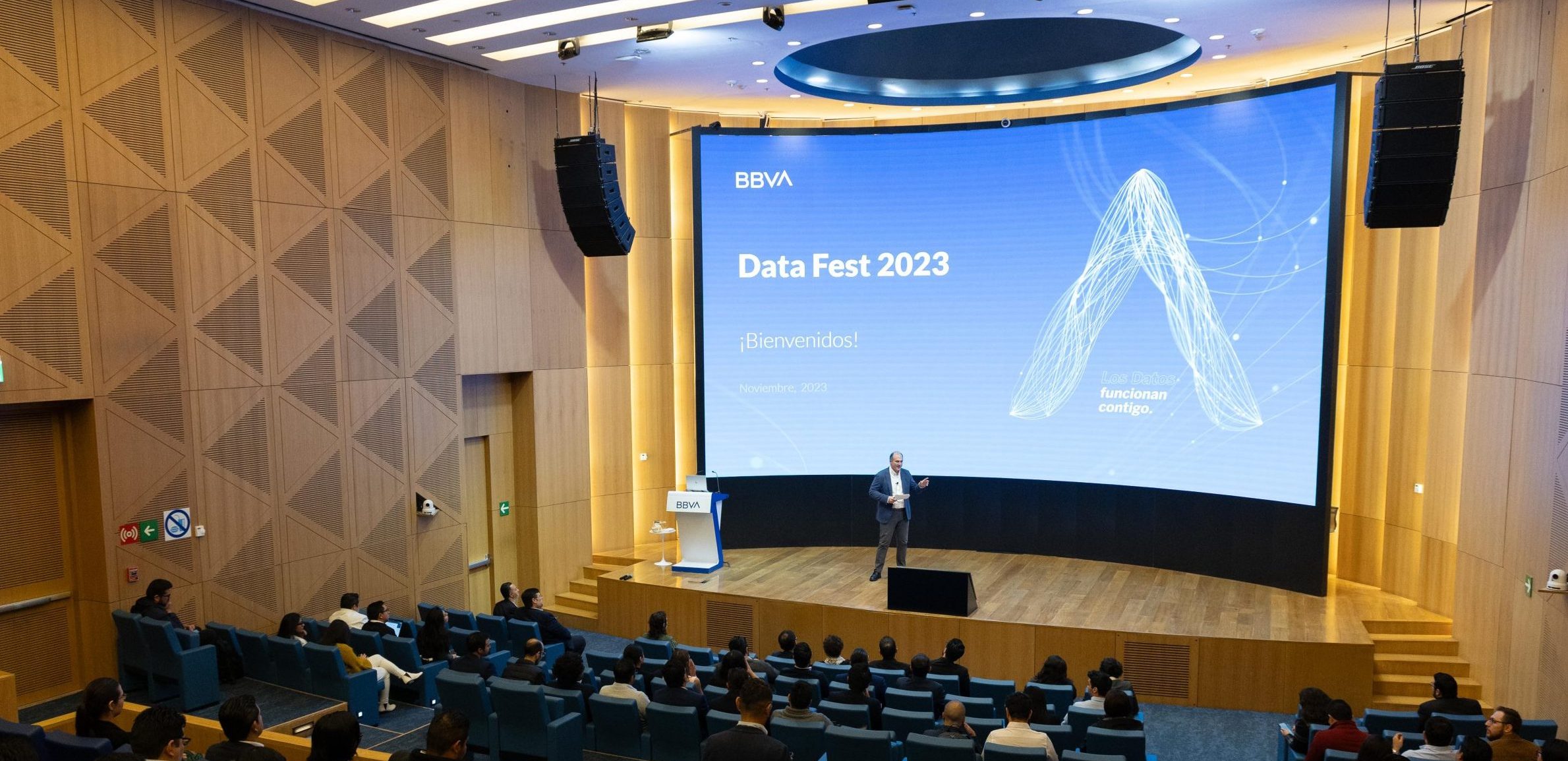
As has become a tradition every November, in the Data area of BBVA, we have held the DataFest, an internal event designed to share knowledge and learning among teams and update the main market trends around data and Artificial Intelligence. This year, the focus was especially on generative AI. Plus, we have counted the participation of two AI referents: Omar Sanseviero, Lead ML Engineer at Hugging Face, and Carlos Santana, disseminator, YouTuber, and professor in AI and ML.
BBVA DataFest is aimed at the bank’s data professionals and is held globally, with teams from Mexico, Peru, and Spain hosting this edition. The different presentations that have made up the agenda, both internal and external guests, have allowed us to broaden the vision and focus on the significant projects in which the bank is immersed, as well as trends that have great potential for transformation in the coming years. This is the case of generative AI, a technology with great transformational power that the bank is already implementing in several projects, which we have approached from different perspectives.
The Deep Learning revolution and the versatility of pre-trained models: the keys to the talks by Carlos Santana and Omar Sanseviero
The presentation by Carlos Santana (dot CSV), communicator, YouTuber, and Machine Learning professor, focused on the evolution and impact of deep learning in our daily lives. According to Santana, the AI revolution is the deep learning revolution, a field of study within machine learning that has undergone accelerated development and transformation in recent years.
Santana identifies three phases in the evolution of deep learning. Version 1.0 comprises traditional neural networks. It is unimodal and primarily based on supervised learning. Today, we are experiencing deep learning 2.0, driven by transformers – the basis of generative AI – and by multimodality, which allows systems to have a more complete and coherent knowledge of reality. Finally, Santana anticipated the future with what could be understood as deep learning 3.0, where reinforcement learning will positively impact scientific progress, and AI and robotics will converge in the physical world.
In this edition of BBVA DataFest we also had the opportunity to listen to Omar Sanseviero, who highlighted crucial points about the future and challenges of Artificial Intelligence. His career as a software engineer has led him to work on Hugging Face, a well-known platform for collaborative AI development, at the intersection between community, open source, and product.
Sanseviero spoke about the paradigm shift from supervised to pre-trained models, thanks to the incursion of Transfer Learning. This type of learning consists of taking ML models already trained, on which a fine-tuning process is performed to adjust them to each use case. In addition, he identified several challenges in using AI models, such as the growing size of models, difficulties in evaluation and customization, and the need for optimization for production implementation. To overcome these challenges, Sanseviero advocates regulation focused on use cases rather than placing barriers to model research and training, as well as giving a central role to the community in creating new solutions.
In this sense, at BBVA we contribute to the open-source philosophy by publishing several analytical components of our Mercury library. This library, which is available for everyone interested, facilitates the creation of Machine Learning models and promotes the reuse of code components on a large scale, something we are experiencing first-hand and allowing us to speed up the development of new data-driven products.
Talking about Generative AI with Carlos Santana and Omar Sanseviero
|
|
Carlos SantanaDotCSV Communicator, youtuber and teacher in the field of AI and ML |
Omar SansevieroHugging Face Lead ML Engineer and Head of Platform and Community |
|
Guest opinion: Carlos Santana and Omar Sanseviero interviews
Carlos Santana
DotCSV
Communicator, youtuber and teacher in the field of AI and ML
Omar Sanseviero
Hugging Face
Lead ML Engineer and Head of Platform and Community
Guest opinion: Carlos Santana and Omar Sanseviero interviews
Carlos Santana
DotCSV
Communicator, youtuber and teacher in the field of AI and ML
Omar Sanseviero
Hugging Face
Lead ML Engineer and Head of Platform and Community
Generative AI at the center of BBVA DataFest 2023
Jon Ander Beracoechea, global head of the Advanced Analytics discipline at BBVA, confirmed that expectations about technological progress are being exceeded, noting that generative AI is accelerating the process. Beracoechea urged colleagues not to limit themselves to the application of this technology to address current needs but also to imagine how it could transform the functions and processes of the future.
“Generative AI could completely change the way the bank operates in the world”, Curro Maturana, global head of the GenAI initiative at BBVA
Curro Maturana, global head of the GenAI initiative at BBVA, described generative AI as “an opportunity that could completely change the way the bank operates in the world.” For this reason, the bank has been actively working on its implementation for more than a year now, first with the creation of a Foundation Models task force in 2022 and, more recently, with the launch of a multidisciplinary team in April 2023 and the launch of its first global project.